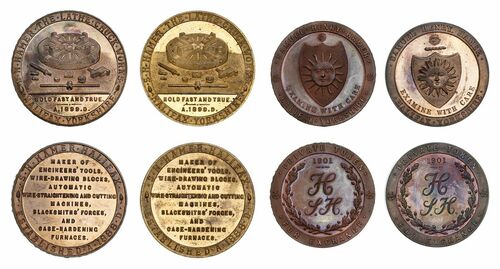
Auction: 24123 - British and World Coins and Medals featuring the Pritchard Collection of 18th Century Provincial Tokens and Commemorative Medals - e-Auction
Lot: 952
YORKSHIRE, Halifax, Samuel Henry Hamer, Bronze Private Token, 1901, radiant sun on shield, eye above, EXAMINE WITH CARE below, rev. cypher in wreath, TIME . ADDS . A . VALUE . TO THIS . TOKEN. RARE on edge, 12h, 23.34g (W 3038), with a rich blue tone to brilliant fields, the surfaces a pleasing red-chocolate brown, much as struck; another, as before, obv. beaded line below eye, plain edge, 12h, 23.35g (cf. D&W p.344), light tooling in the obverse field, otherwise with a pleasing lustre, toned to the reverse, bolder extremely fine; Samuel Henry Hamer, Trade Token, 1899, lathe chuck and accessories, rev. ten-line inscription, I . PROMISE . YOU . BEST . VALUE . FOR . YOUR . MONEY TRADE - TOKEN on edge, 12h, 25.55g, some minor scuffing to lustrous and mint red surfaces, much as struck; another, struck in brass, plain edge, 12h, 25.48g, much as struck (4)
The Pritchard Collection of 18th Century Provincial Tokens and Commemorative Medals
Samuel Henry Hamer, the esteemed academic voice on the subject of Britain's token coinage, should also be remembered for his contribution to the striking of token coinage. In the 1890s he chose to issue these tokens for the town of Halifax, Yorkshire. In his British Numismatic Journal entry in 1906 he wrote on the subject; 'During the periods in the eighteenth and nineteenth centuries, when tokens were being issued throughout the country, none were issued for currency by anyone at Halifax. Nor were any private tokens issued there prior to 1899. In that year, to encourage the issue and exchange of such pieces, I had dies sunk of two obverses and one reverse for private tokens. These were used with a plain collar.
In the following year I had a similar series of dies sunk, the tokens in this instance being struck in a three-split collar with the legend I . WILL . EXCHANGE . MY . TOKEN . FOR . AN . APPROVED . ONE, two acorns and a pellet separating the beginning from the end of the reading.
In the year 1901 I had two pairs of dies sunk, the design of each obverse being of an emblematical character, intended to show the desirability of obtaining the best information on any subject with a view of arriving at an equitable decision. A three-split collar was again used, engraved with the lettering TIME . ADDS . A . VLUE . TO . THIS . TOKEN . RARE ., an eye between two oak leaves separating the beginning from the end of the legend.
All the dies were engraved and the tokens struck at the works of J. A. Restall, at Birmingham; the number of each series being but small.'
S. H. Hamer, 'Notes on the Private Tokens, Their Issuers and Die-Sinkers', Part 3, British Numismatic Journal, Volume 3, 1906
Subject to 20% VAT on Buyer’s Premium. For more information please view Terms and Conditions for Buyers.
Sold for
£220
Starting price
£60




